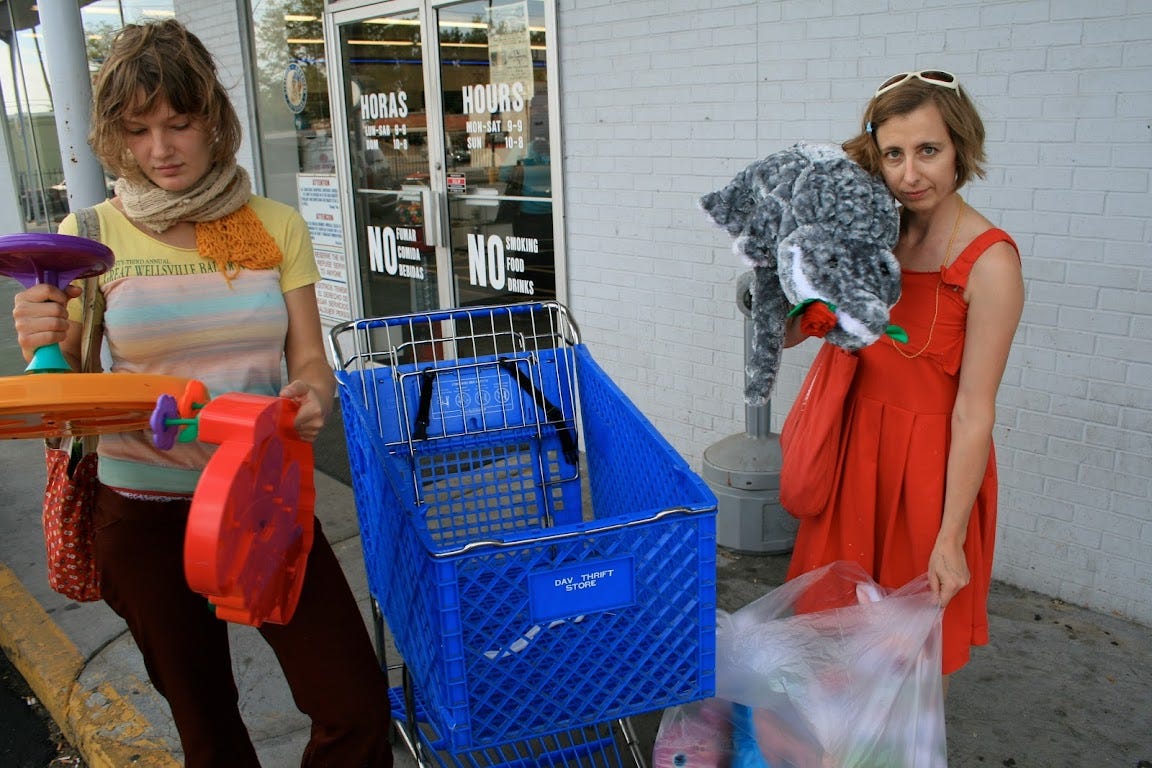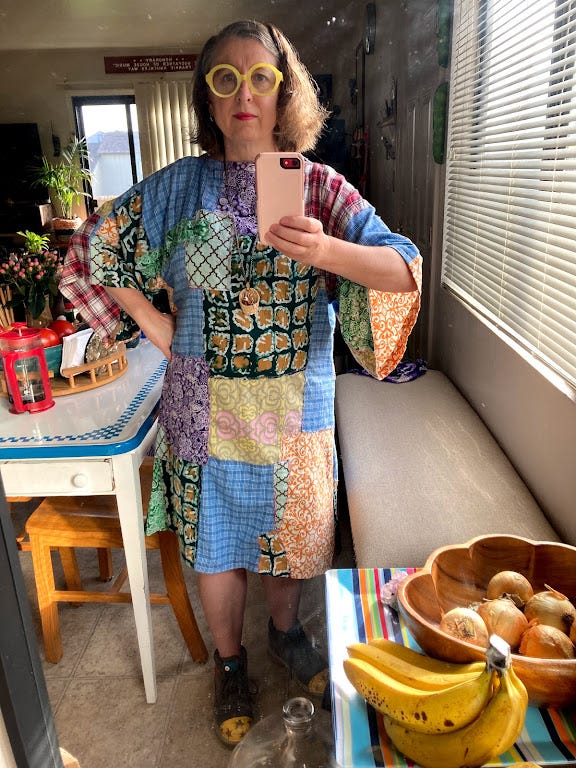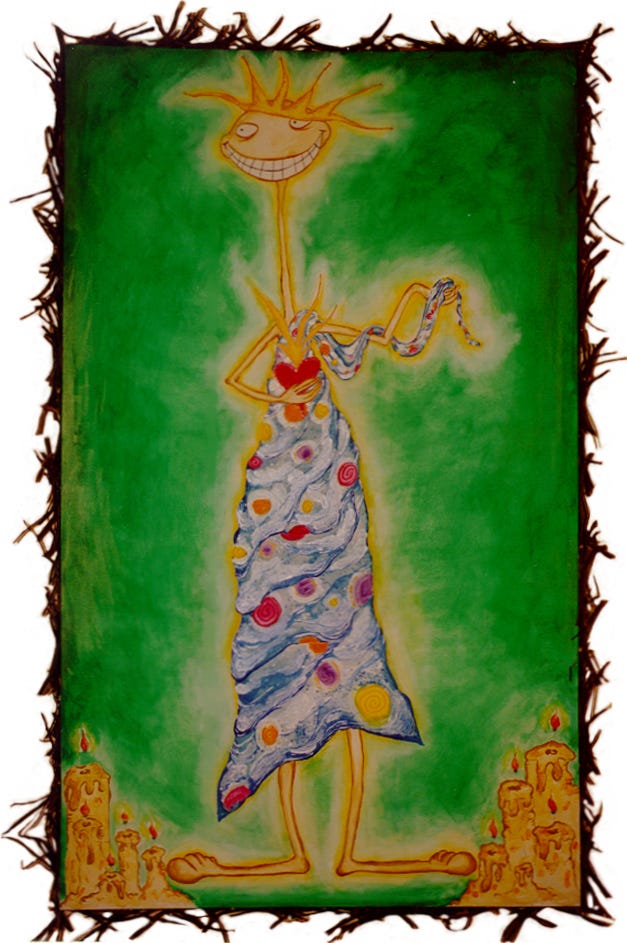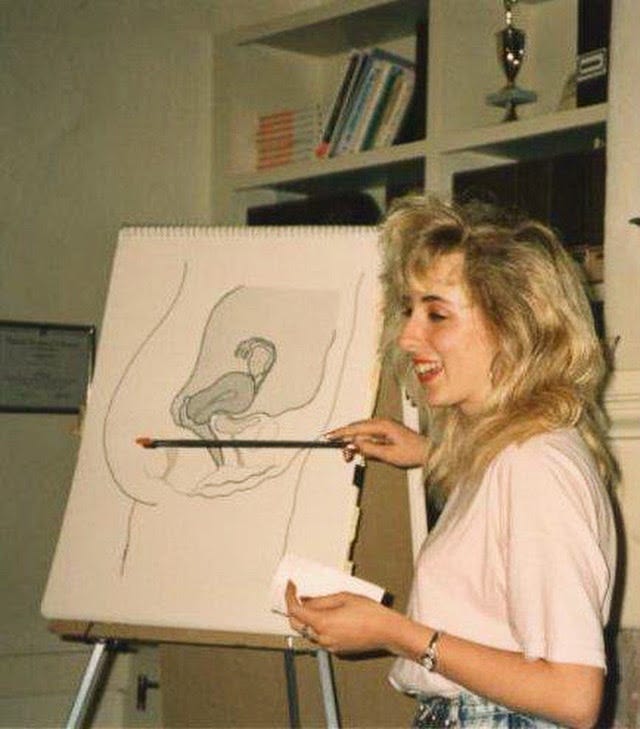It’s the start of another autumn and I’ve been thinking about “repair” as a way to not only live with the things I have but also as a way to (possibly) more effectively express myself in a creative manner.
I’ve been thinking about the blurred lines between art, utility and currency. The social currency of objects and the emotional currency made by feeling a connection to our objects (art and fashion included). Spiritual things. Practical things. The illusory.
It’s been important for me to look for the sources of motivation, or sources that lead one “off the track” toward something authentic. What makes me want to search outside of what I have, or what I am, in order to feel something closer to fulfillment?
When I was a teenager, during the late eighties, and wanted to sort out some kind of spiritual life, I attended a Christian church and Sunday school that some of my friends and their families were members of. Church was something that seemed so “normal,” and it wasn’t a part of my own family’s life. I wanted see what it was all about so was easily lured into their youth group by way of a weekend ski trip they hosted that sounded like a fun, and it mostly was. I recall the times with my friends, laughing on the long bus ride to the lodge as the chaperones shushed and shushed and shushed us- and the delight we California beach kids all shared in leaping out of the bus onto piles of fallen snow.
During the Sunday services and youth events I attended before and after the trip, I listened to what the preachers and leaders told us all- and while the intentions were to help people, as well as create supportive church attendees, the stories and lessons didn’t lead me to the kind of inspiration, or healing paths I was searching for.
The way I perceived it, the sermons were not unlike taking a class that required a prerequisite course I lied about taking. I felt something had been skipped over, but soon realized that I lacked a familiarity with this world. A lot of it had to do with agreement and trust and I guess my neurons had not been trained to connect to whatever it was that it needed to, to buy into it all. I felt like a nuisance when I asked questions so I tried mimicking my fellow pewed peers and nod in agreement to show that it all made perfect sense. ”Praise him, yes praise him,” I’d mumble-repeat with my tiny green bible in hand. None of it felt right.
I understood (but didn’t yet trust) the part of me that could know love, tolerance, and kindness, as well as a connection to something bigger that included the joys and mysteries of being alive here, together, and I expected my church experiences to lead me to accessing those things in a clearer, maybe truer way, in addition to taking me skiing for only the cost of renting my own skis. I assumed I’d get some answers. Instead, I was preached at during meals after skiing and at night before bed after skiing and on other Sundays, offered a set of beliefs that were formed by way of regurgitated tales by a group of people who required a devotion to their version of a popularly agreed-upon savior. We all need something to believe in and this was/is as good as anything else. It just wasn’t something for me.
So what does my church story have to do with repair and ownership of objects?
Before trying to figure that out, let’s fast forward to a few years later when I worked for a living. I used my own earned money and got a bunch of credit cards to purchase objects I quickly learned I could use as collected representations of my identity.
I learned from others in my community and in fashion magazines, in music videos, television shows and movies about the objects we could own that would say some things about who we are. The social currency of brand names, in all its forms: clothes, kitchen appliances, cars, technological gadgets, the credit cards themselves, hair products, food products...
I made choices that I now know were not the best ones for me, in order to be in a place where I could fit into the world where people could possibly view me as creative and wealthy and interesting- because my outward expression of having all these things included agreed upon symbology.
When it came to the church experience, it was relatively easy to see and experience some types of hypocrisy that led me to trust myself more than “them” and develop my own, evolving, spiritual belief systems. Sermons bored me and I quickly learned that the boy the church doted on was secretly a pushy, horny teen- worse than rest of us heathens, which is what I felt increasingly perceived as within that community. On top of that, we were shown a propaganda film that shared lies about abortion with staged images of fully formed babies piled lifeless and bloody behind a shack (fake abortion clinic) and scenes with several young women in tears, stating how their lives were ruined by not choosing to give birth. At that same time I was training at Planned Parenthood in order to teach my peers sex and AIDS education. My reason for taking on this volunteer work had to do with my budding enthusiasm for public speaking, but the dichotomy between the information shared by the two organizations allowed me to make the decision I knew was right for me. I left and never looked back.
The Mall
Sermons are boring but shopping is fun. Obviously, capitalism and consumerism have proven to be a bit trickier to sort out-
During the times when I sat/sit in front of the pulpit of corporate influence and tithe/d by way of pouring cash into the pockets of billionaires (in trade for the hope of another form of salvation), I felt a lack of connection to how I was “supposed” to go about things, in a same manner that I did in church. But it was harder to accept this kind of internal critique, as objects and things make life easier. Especially if they are made by a well-established and trusted brand. The church I attended worked by way of increasing feelings of guilt within me, but as I write this, I realize at least one of the things the two systems share in common is how they work hard to keep us from trusting our instincts. (Not that our instincts are always trustworthy. I acknowledge that belief systems and a being encouraged to purchase pricey, well-made shoes as opposed to platform sandals from Hot Topic when you are in your forties can both be very helpful things.) They work on reaching some of our more “animal” reactions while easing some of our burdens, in order to maintain power and control. They need to keep us needing, getting and wanting.
I often go back to a memory of myself in my twenties in a brightly lit kitchen with granite countertops and a giant metal mixer and all sorts of purchased gadgets that made coffee and waffles and grilled and separated and frothed and fried… and of course they all matched whatever was built into the space already. Everything I had wasn’t even as big or nice as things people I knew owned. There were still more things to purchase; more work to be done to reach the level of what I should “be.”
Those times in that kitchen when I appreciated all that I had and lived within (and I did appreciate it) were met with a feeling that I should have started out with some basics. Some older things, perhaps handed down. I should have been in a kitchen where my shelves were not the most ideal, but good enough. I had this fantasy of creating something visually attractive and useful, by way of personalization and repair. I wanted some kind of ownership that the purchasing of shiny, new objects didn’t allow. It was all already done for me.
And it was all so much nicer than anything I had ever owned! My aesthetic dissatisfaction was met with the part of me that recognized how fortunate I was to live in such a space, even if it came at a cost I would eventually realize I could not afford.

A friend of mine recently introduced me to the idea of using the term, pedigree, in regard to clothing and objects, which is interesting. I also worry a bit about that term, because it perhaps can lead to a bit too much weight being placed on the value of objects, which in the end (getting back to the whole church thing), can’t come with us.
But what was missing then and what I wanted was something like that, and it’s what repair is giving me- a person who wasn’t taught to care for objects for a lifetime. Who was led to consider more of the impermanence of everything. I think about those days in that kitchen though, because I’ve been having moments-twenty-three years later, where I realize I have learned to follow my instincts more. I’ve come to feel very confident in my ownership of objects and the presentation of myself. It took this long and so many challenges and changes to reach that elusive feeling I had as a young woman. Like it was a call from me now to me then, or vice-versa.
All that said, I do still shop in terrible chain shops and engage in the use of branding as currency, from time-to-time. It’s an agreed upon language, and we can’t really engage well without accepting at least some sources of convenience, after all. I also have developed and rely upon my own versions of faith where I believe in so many comforting yet admittedly ridiculous things. It’s all such a mental battle, seeing as how we don’t know what we are- I’m flawed. I’m trying. Praise him, praise her, praise them! Blessed be.
But what does this have to do with art?
Practicum (on the topic of repair)

While I was in art school in the Midwest, I started to explore and embrace the repurposing of clothes as-art-concept. I had started to think about something that seemed only practical, in a new way. Of course all of us in art school explored our identities to outrageous degrees. It was a great space of freedom.
Of course, as well, the lack of funding for outrageous or even simple garments that defined who I was learning I was as an “art-person,” was a very real thing. Second-hand clothing was very easy to find at thrift stores and a nearby church (ha!) rummage sale that happened every fall where one could fill a large garbage bag for only ten dollars and take home whatever would fit. My roommate and I would go to this yearly event for needed things like blankets and found art-supplies, but we also poured clothes into the giant plastic sacks we eventually slumped over our hunched backs and schlepped the block or two back to where we lived.
One summer, while on break from school and visiting my parents in California, I was given a couple clothing items. I decided to hand-sew adjustments to two big skirts and made dresses out of them that appeared remarkably similar to the art I had been making, through the lines made by stitches, cuts and folds. Before that I had been making t-shirt dresses in my dorm room, by sewing parts together by hand. Everything had been done by hand until my junior year when a fellow art student had briefly tried to use sewing practices within his painting works. He moved back to paint and I got a used sewing machine. The following summer I made a few dresses out of tops and parts of shirts, and once even a jersey bed sheet. The machine sped things up. The winter of my senior year, I was stuck inside for a lot of our holiday break as it was a particularly snowy season. I used that time to create an entire wardrobe that I actually showed during an end-of year fashion show, with friends as models. Those clothes were what I wore during my time at grad school, as well.
I had transmuted my autobiographic works, or added a new angle.
My way of stitching is particular, and I’m not very concerned with following the rules of sewing, unless needed to express my vision or create something sturdier than I might otherwise. The act of manipulating clothing as a part of my growth as an artist and person who wanted to stop searching outward sources for self-definition was very special and I consider myself so lucky. I’m lucky because there were others around me, during critiques and other times of making, where the dialog around my interest in fashion and personal identity was directly linked to the paintings and sculptures and performance art piece I was developing and sharing. They were more than clothes and they were more than objects. They were perceived by my peers as being from me and of me. The challenge now is to use and reuse more of what is here, as my source materials. To embrace more of the history an object or garment has, as well as staying vigilant to how I put to use things purchased or given to me. How to arrange things in an artful way. To use selectivity, repair and care as a means to stay more closely connected without going too far along the lines of “collector.” Sometimes giving something away is the right choice. (This isn’t a defense for hoarding.)

In conclusion?
Well, I started this latest “newsletter” with the intention of sharing some of my personal explorations I felt could relate well to others, but I end it feeling struck more by the idea of biography and how I’ve been drawn to it for so long.
The art and photos that I shared here are all old, aside from the dress below. They reflect those past questions or feelings that were mine “before,” and they helped me consider my desire for the kind of life I’m just now getting to. I have new works that explore form and objectivity and I spent September working on them, as well as repairing/renewing clothing items and things around my home.

In any case, the summer here is done and gone and soon it will be darker and colder. It feels like autumn. The start of the last harvest of the season! I’ve been working on this newsletter for the month of September and have been glad for it allowing me to wrap up some summer things and consider how repair and personal meaning add to my identity and work as an artist. I’d love to hear what repair means to you, or any thoughts you have on some of the things I’ve touched on. Please leave a comment if you feel so inclined and thank you very much for reading.







I really enjoyed reading this and learning more about your background and art process, Linda. Especially now that I'm in the midst of a "recycled clothing shopping as therapy" as therapy phase. Also been thinking about repairing things and sewing -- but have always been sort of intimidated by the sewing process (my mom was a kickass seamstress). Maybe I can start in small ways...